 |

 |
 |
BÏF§ZF+18 simultaneità e chimismi lirici (A§Lot+18 Simultaneity and Lyrical Chemistry), Ardengo Soffici, 1915
© Eredi Soffici, Italy
This image is a title page for a words-in-freedom collection. The cover is a typographic collage suggesting overlapping title pages of important Futurist journals.
|
 |
In 1909 a handful of Italian artists and poets published a manifesto for a new movement called Futurism. The artists declared that scientific and technological inventions of the modern world had altered concepts of time and space, causing a deep change in the human psyche. Traditional cultural institutions, they asserted, must be destroyed and new ones created. Futurists followed this with manifestos calling for the reinvention of everything from painting, music, and architecture to cooking, warfare, and government.
Between 1913 and 1920, a number of Italian Futurist journals flourished, with pages devoted to what Futurists called parole in libertà, or "words-in-freedom." In order to mimic the speed and dynamism of contemporary life, this new kind of poetry rejected conventional grammar and punctuation and employed devices from non-linguistic domains. Existing at the intersection of art and literature, these poems were to be read visually and verbally, vertically and horizontally, iconographically and analytically.
|
 |

 |
 |
"Tipografia" (Typography), Ardengo Soffici, 1915
© Eredi Soffici, Italy
|
 |
 |
Creative typography was central to the Futurists, who believed the visual qualities of letters and words should be elements of a poem's meaning. In a kind of ode to typography, Ardengo Soffici parodies the imagery and exalted emotion of the Symbolists, while literally breaking apart traditional poetic structure, casting stanzas among jumbled letters of various fonts.
These poems, which were meant to eradicate traditional literary modes, paradoxically used obsolescent manual word and type settings and required outdated printing molds to hold the types in place. Thus, the Futurists' "telegraphic" style was enormously time-consuming to create.
|
 |
 |
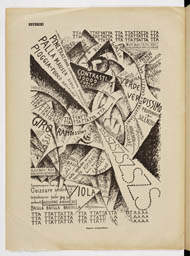
 |
 |
"Danza serpentina" (Serpentine Dance), Gino Severini, 1914
© 2006 Artists Rights Society (ARS), New York / ADAGP, Paris
|
 |
 |
|
This collage is an example of a painter's interpretation of the words-in-freedom. The artist explained that his use of forms, colors, and words suggest analogies between a dancer's movement, a whirring propeller, and a flying bullet.
Color words—some paired, some contrasting (e.g., blue/yellow, red/very green, violet)—and other devices evoking vibrations of light and sound reflect the interest Futurist painters took in pseudoscientific theories linking specific physiological responses to individual shapes, colors, and sounds.
|
 |
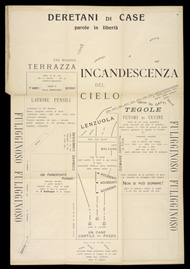
 |
 |
"Deretani di case" (Backsides of Houses), Vincenzo Volt, 1916
|
 |
 |
|
|
 |
This words-in-freedom uses the form of an architectural elevation to structure a dynamic narrative about daily life in a neighborhood in Rome. The image describes the "backside" view of two bourgeois homes separated by a courtyard, complete with latrine, sooty sewage pipes, and refuse in the courtyard well.
The poem draws comparisons between various kinds of love. A lover flashes signs from the terrace on top of the building on the left, while cats mate on the opposite rooftop. Glances flow between servants across the courtyard in the center, while disappointed lovers occupy parallel rooms on the lower floors.
|
 |
 |
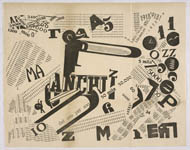
 |
 |
"Une assemblée tumultueuse. Sensibilité numérique" (A Tumultuous Assembly. Numerical Sensibility), Filippo Tommaso Marinetti, 1919
© 2006 Artists Rights Society (ARS), New York / SIAE, Rome
|
 |
When World War I broke out in Europe in August 1914, the Futurists greeted it as the crystallization of their ambitions, indeed, as the ideal expression of their cult of violence, energy, and machines. Their visual poem was suited to capturing the experience of the modern battlefield, with its chaotic emotions and man-made sounds.
Although Marinetti's "Tumultuous Assembly," at right, seems an abstract composition of numbers, words, and shapes, some elements suggest a celebration after World War I. In the upper right is the year 1918, and a small drummer marches on the lower left. The sheets of numbers evoke gathered crowds, or the dead and missing, the latter suggested by the black clocklike shapes.
|
 |
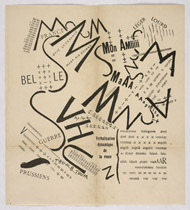
 |
 |
"Après la Marne, Joffre visita le front en auto" (After the Marne, Joffre Visited the Front by Car), Filippo Tommaso Marinetti, 1915
© 2006 Artists Rights Society (ARS), New York / SIAE, Rome
|
 |
 |
|
|
 |
This poem celebrates the Battle of the Marne, in which the Allies stopped the German conquest of Europe and established the Western Front. Fashioned like a military map, Marinetti's poem portrays General Joseph Joffre's victorious tour of the troops after battle.
The general follows winding roads in spirals that evoke his reversals in military strategy. The letter M simultaneously refers to the word "Marne," renders the outline of mountains, and is the first letter of the words the general speaks: "Mon ami" and "Ma petite." The troops respond, "Vive la France" and "Mort aux boches" (Death to the Germans), while the "ta ta ta ta" and "toumb toum" of gunfire continues, at least in memory.
|
 |
 |
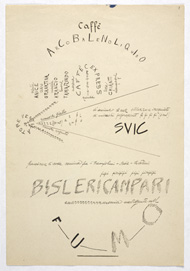
 |
 |
"Caffè Arcobaleno Liquido" (Café Liquid Rainbow), Angelo Rognoni, 1916
© Eredi Rognoni, Italy
|
 |
 |
|
Angelo Rognoni's unpublished manuscript "Factory + Train" loosely traces a day in the life of a modern artist-poet. Rognoni's poet begins his day in a café, the locus of urban life, where one can acquire a feeling of inner speed for the price of a cup of coffee. Colors, sounds, and smells all evoke the pleasant and relaxed feel of this café.
The title, "Café Liquid Rainbow," is an arch, as if over the café door. Bottles are lined up above the bar (orange, lemon, tamarind). The "rrrrrrr" and "svic" sound of the electric fan—a relatively new machine at the time—has a magical quality, with a "yellow sound of the spirit of things restlessly fluttering," and a "silver sound of phosphorescent microbes."
|
 |
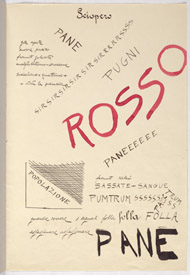
 |
 |
"Sciopero" (Strike), Angelo Rognoni, 1916
© Eredi Rognoni, Italy
|
 |
 |
After visiting the café in the image above, Rognoni's poet proceeds to a town fair; to the hills above the town; to a boat ride on a lake; back to town for a Futurist evening; to a drunken Futurist meeting; and to the red-light district. His day culminates the following morning, in the poem at left, when after vomiting and still hung over, he experiences a strike and a bread riot in the piazza.
Although many European intellectuals shared the Futurists' enthusiasm for World War I as a necessary passage to modernity, the unprecedented carnage of the war led many to an antiwar stance. The tumultuous years after World War I saw acute social unrest, leading eventually to Fascism in Italy. Something of this instability is already present in Rognoni's manuscript, where the bread riot depicted in "Strike" ends with beatings and buildings in flames.
The exhibition is located at the Getty Center, Research Institute Exhibition Gallery.
|
 |